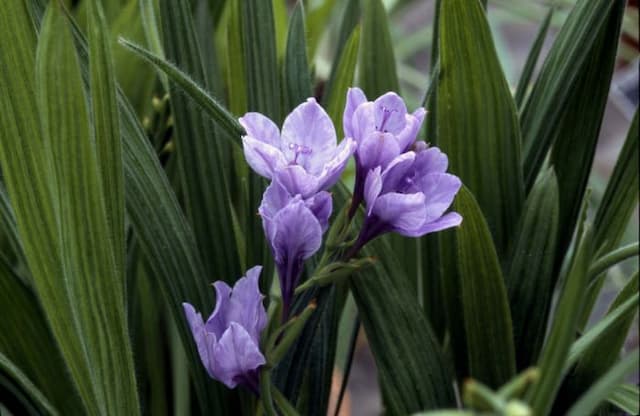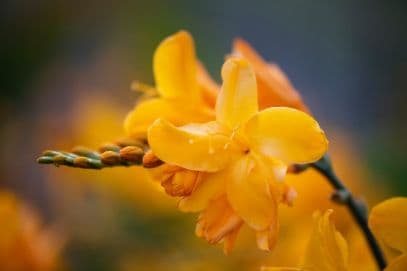Dwarf Iris Iris 'Joyce' (Reticulata)

ABOUT
Iris 'Joyce' (Reticulata) is a captivating and beautiful flowering plant that showcases striking blossoms. These flowers exhibit a delightful blend of colors with deep blue to purple petals. The petals may have a bold yellow or white patch that's often decorated with a characteristic intricate pattern, making the flowers look like they are etched or painted by hand. Each blossom typically has six lobes: three outer 'falls' that curve downwards, and three inner 'standards' that stand upright, giving the plant an elegant symmetrical form. The flowers exude a sweet fragrance, adding an additional sensory appeal to their already stunning visual presentation. Below the blooms, narrow, blade-like leaves emerge, forming a grassy tuft that complements the flowers with a lush, green backdrop. These leaves are generally a bright, fresh green tone and may have a glossy or slightly ribbed texture, adding to the plant's overall aesthetic. Overall, the Iris 'Joyce' is a vibrant addition to any garden with its cheerful blooms and pleasant aroma, making it a beloved choice among garden enthusiasts. It blooms in early spring, being one of the first splashes of color in the garden after the winter.
About this plant
 Names
NamesFamily
Iridaceae
Synonyms
Joyce Dwarf Iris, Joyce Reticulated Iris, Joyce Iris Reticulata
Common names
Iris 'Joyce' (Reticulata)
 Toxicity
ToxicityTo humans
The Iris 'Joyce' or more commonly known as simply Iris, contains compounds that can be toxic to humans if ingested. The most toxic part is the rhizome, which if consumed, can lead to symptoms such as nausea, vomiting, abdominal pain, and diarrhea. Ingesting large quantities could result in more serious issues such as liver damage or even life-threatening complications.
To pets
Similarly, the Iris 'Joyce' or Iris is toxic to pets including both cats and dogs. When ingested, the plant can cause symptoms like drooling, vomiting, diarrhea, lethargy, and abdominal pain. Severe poisoning can lead to dehydration, tremors, or even organ damage in pets. It's essential to prevent pets from consuming any part of the plant.
 Characteristics
CharacteristicsLife cycle
Perennials
Foliage type
Deciduous
Color of leaves
Green
Flower color
Purple
Height
4-6 inches (10-15 cm)
Spread
2-3 inches (5-7.5 cm)
Plant type
Bulb
Hardiness zones
5
Native area
Caucasus Turkey
Benefits
 General Benefits
General Benefits- Decorative Appeal: Iris 'Joyce' offers striking deep blue to purple flowers with a contrasting yellow or white pattern that adds visual interest to any garden or landscape.
- Early Spring Bloom: It is among the first flowers to bloom in spring, providing a much-needed splash of color after a long winter.
- Low Maintenance: This Iris is relatively easy to care for, requiring minimal maintenance once established in a suitable location.
- Drought Tolerance: Once established, Iris 'Joyce' has good drought tolerance, making it suitable for gardens with limited water availability.
- Hardiness: Iris 'Joyce' is hardy in a range of climates and is capable of withstanding winter temperatures with minimal protection.
- Attracts Pollinators: The vibrant flowers of Iris 'Joyce' attract bees and other pollinators, supporting biodiversity.
- Compact Size: Its small stature makes it a perfect choice for rock gardens, borders, and containers where space is limited.
 Medical Properties
Medical PropertiesThis plant is not used for medical purposes.
 Air-purifying Qualities
Air-purifying QualitiesThis plant is not specifically known for air purifying qualities.
 Other Uses
Other Uses- The cut flowers of Iris 'Joyce' are often used in small, delicate floral arrangements to provide a pop of color and enhance the fragrance of a space, as their small size is suitable for miniature bouquets.
- Dried petals from this iris variety can serve as a natural source of dye for textiles or crafts, bestowing a soft, subtle hue to fabrics and materials.
- These irises can be planted in outdoor fairy gardens, where their diminutive size and vivid blossoms create a magical landscape suitable for the imagination.
- Iris 'Joyce' can be used in educational settings such as schools or botanical gardens, where students and visitors can learn about bulb propagation and seasonal growth cycles.
- The plant's attractive foliage and early spring blooms make it a perfect choice for enhancing the aesthetic of green roofs where conditions are appropriate for its growth.
- In low-traffic urban areas, they can be planted between pavement cracks as part of a beautification effort to add color and life to concrete-dominated spaces.
- The iris can play a role in artistic photography projects where its intricate petal patterns and vibrant colors are captured up close as a study of natural beauty.
- Garden designers utilize the Iris 'Joyce' in rock gardens, taking advantage of its low growth habit and early flowering to establish visual interest before other plants bloom.
- As an addition to wildlife gardens, its early blooms can provide an essential food source for pollinators emerging in the spring months.
- The plant might also be considered for use in miniature corsages for special events such as weddings, particularly for a springtime theme.
Interesting Facts
 Feng Shui
Feng ShuiThe Iris is not used in Feng Shui practice.
 Zodiac Sign Compitability
Zodiac Sign CompitabilityThe Iris is not used in astrology practice.
 Plant Symbolism
Plant Symbolism- Hope: The iris often signifies hope, an expectation for something positive in the future.
- Trust: It can represent trust, showing that the giver believes in the integrity and reliability of the receiver.
- Wisdom: Historically connected with royalty and the divine, irises can symbolize wisdom and valued knowledge.
- Courage: In some context, the iris encourages boldness and bravery, possibly inspired by its striking appearance.
- Purity: Like many flowers, irises can also stand for purity and innocence, with their clean lines and shapes hinting at an unmarred ideal.
 Water
WaterDwarf iris should be watered deeply but infrequently to mimic their natural habitat, which typically experiences dry summers and wet winters. In the growing season, ensure the soil is moist but not waterlogged, watering approximately once a week with about one gallon of water per square yard. During dormancy after blooming, reduce watering significantly to prevent rot. If rainfall is scarce, water just enough to keep the bulbs from drying out completely, which may equate to the same gallon per square yard, but only monthly.
 Light
LightDwarf iris thrives in full sun where it can receive at least six hours of direct sunlight daily. The best spot for this plant would be a south-facing or west-facing garden that maximizes exposure to sunlight. Partial shade is also acceptable, especially in very hot climates where some afternoon shade can prevent scorching.
 Temperature
TemperatureDwarf iris prefers cooler climates and typically does well in temperatures ranging from 35°F to 75°F. They can survive brief periods of colder weather, down to around 20°F, but extended freezes might damage the plant. The ideal temperatures for promoting growth and flowering are between 50°F and 70°F.
 Pruning
PruningPruning dwarf iris involves removing dead or spent flowers and foliage to encourage healthy growth and more blooms in the following season. Prune after flowering by cutting back flower stems to the base of the plant. Leaves should be left intact to die back naturally. The best time for pruning is late summer or early fall, after bloom period has ended.
 Cleaning
CleaningNot needed
 Soil
SoilDwarf iris 'Joyce' thrives in well-draining soil with a pH of 6.0 to 7.0. The best soil mix consists of loamy or sandy soil enriched with organic matter such as well-rotted manure or compost to promote good drainage yet retain adequate moisture.
 Repotting
RepottingDwarf iris 'Joyce' typically does not require frequent repotting. Repot every 3 to 5 years or when you notice the bulbs have multiplied and are crowded, ideally after the foliage has died back post-flowering.
 Humidity & Misting
Humidity & MistingDwarf iris 'Joyce' is tolerant of a wide range of humidity levels; however, it prefers normal outdoor humidity. Excessively high indoor humidity should be avoided, as it may promote fungal diseases.
 Suitable locations
Suitable locationsIndoor
Plant in well-draining soil, ensure bright light, and avoid high humidity.
Outdoor
Plant in full sun to partial shade, well-draining soil, and prepare for winter dormancy.
Hardiness zone
4-9 USDA
 Life cycle
Life cycleThe Iris 'Joyce' begins its life cycle as a bulb, which is typically planted in the fall. After a period of winter dormancy, the bulb sprouts in early spring, sending up narrow, grass-like leaves. Shortly thereafter, the plant produces its distinctive purple or bluish flowers, usually in late winter to early spring, depending on the climate. Once flowering is complete, the Iris 'Joyce' sets seed, with the seed pods developing where the flowers were. As temperatures rise in late spring to summer, the foliage begins to die back and the plant enters a period of dormancy, conserving energy within the bulb. The cycle starts anew the following spring when the temperatures are cool again and the bulb senses the change in season.
 Propogation
PropogationPropogation time
Spring
Iris 'Joyce' (Reticulata), commonly known as Reticulated Iris, is often propagated through division of their bulbs, ideally right after the foliage has died back, usually in late summer or early fall. To propagate by division, carefully dig up the clusters of bulbs and gently separate them. Each individual bulb that has a portion of the base plate will likely grow into a new plant. Replant the bulbs at a depth roughly three times their height, spacing them about 3 to 4 inches (approximately 7.5 to 10 centimeters) apart to give each new plant enough space to grow. Water the new plantings well to help establish the roots. This method is popular because it is straightforward and typically results in a good rate of successful plant establishment and flowering in subsequent years.









